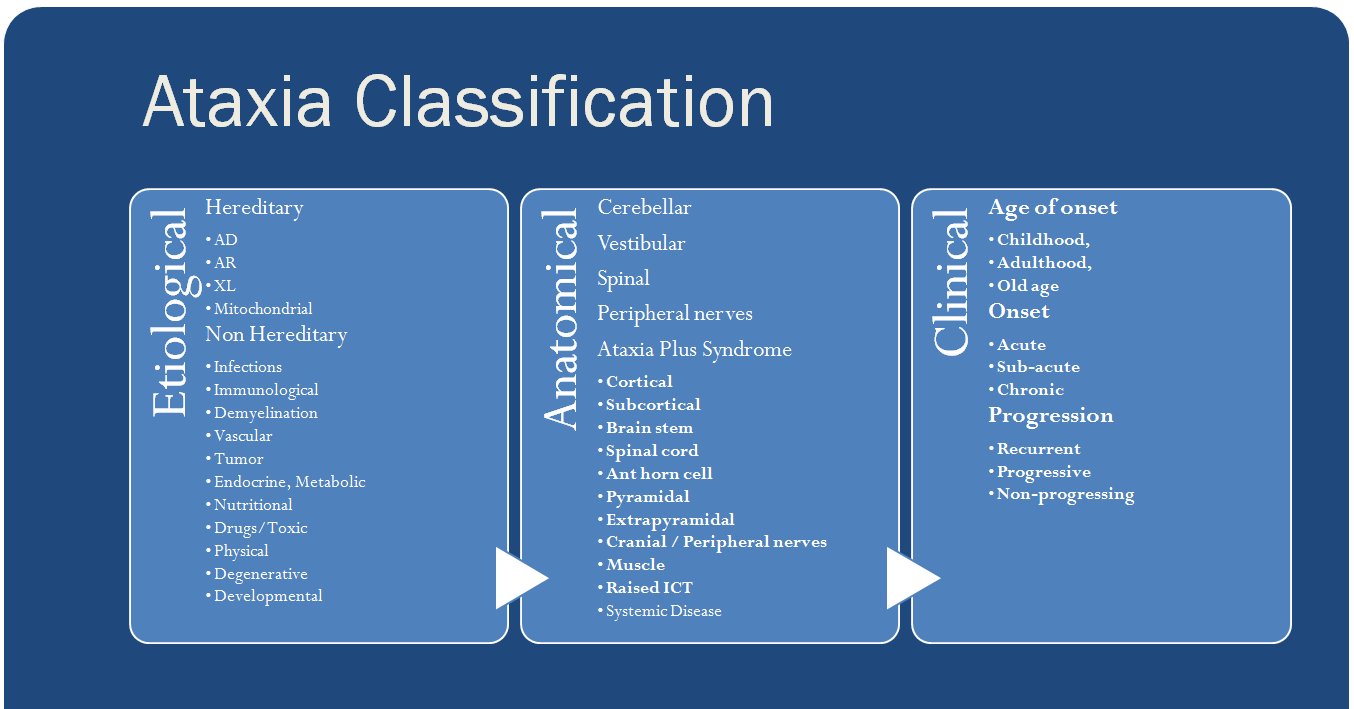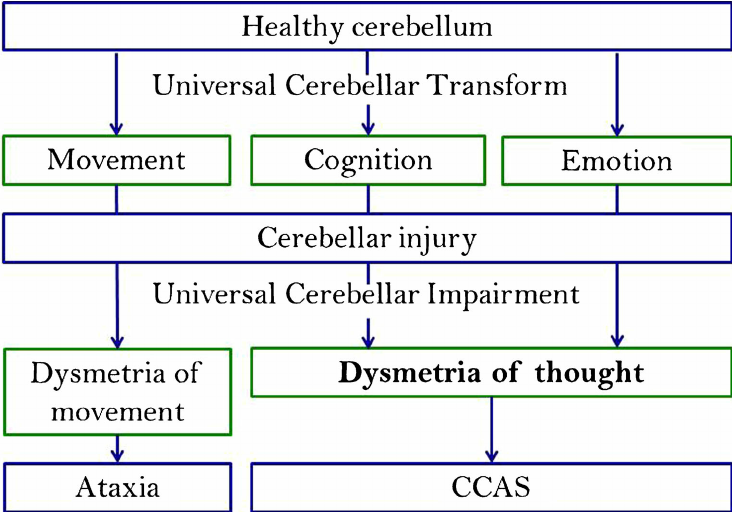Difference Between Ataxia and Dysmetria
What is ataxia and dysmetria?
Ataxia is an unsteady, wobbly, shaky and swaying walk, often with feet placed extensively apart. Individuals find it hard to walk in a straight line with their heels touching the toe of the foot wear in front (the drunk test). Ataxia can happen in a number of neurologic conditions. Dysmetria (a type of ataxia) is making the wrong calculation of the distance to a target.
Similarity
Both are best described as neurologic conditions.

Ataxia
Ataxia can happen in a number of neurologic conditions. It is the impaired balance or coordination – usually happens because of damage in the central nervous system (brain), nerves or muscles.

Dysmetria
Dysmetria is making an incorrect estimation of the distance to a target. An individual with dysmetria will face issues reaching out and will mostly inaccurately touch a targeted object.
Difference between ataxia and dysmetria?
Definition
Ataxia – any type of uncoordinated movement is called ataxia. It is a neurological condition with issues like muscle coordination or control. Individuals with this condition have issues in movement, speech and movement
Dysmetria – a type of cerebellar ataxia
Types
Ataxia
- Cerebellar ataxia – caused due to dysfunction of the cerebellum and is sudden, uncoordinated muscle movement
- Sensory ataxia – accompanied by hypotonia (decreased muscle tone), asynergy, dysmetria, dyschronometria (an individual cannot accurately estimate the amount of time that has passed (i.e., distorted time perception)), and dysdiadochokinesia (the inability to defined as the inability to perform rapid alternating muscle movements) and is caused by the deterioration of the functioning of the somatosensory nerve (a 3-neuron system to provide sensory feedback to the central nervous system continuously and to respond to changes at the surface or inside the body), which results in the interruption of sensory feedback signals and hence, the body incoordination is caused.
- Vestibular ataxia – It is classified as vestibulocerebellum (the phylogenically oldest part of the cerebellum, which regulates balance and eye movements), spinocerebellum (Pertaining to the spinal cord and the cerebellum), cerebrocerebellum (located in the back of your brain. It helps with the coordination and movement related to motor skills, especially involving the hands and feet) and is caused by middle or inner ear infection
Dysmetria
- Hypermetria – caused by lesions in the cerebellum, is when you overreach or overstep.
- Hypometria – caused by lesions in the cerebellum, is when you underreach or under step
- ;
Causes
Ataxia
- Head trauma (injury to your brain or spinal cord)
- Stroke
- Cerebral palsy
- Autoimmune diseases like multiple sclerosis, celiac disease sarcoidosis can result in ataxia
- Infections – viral infections such as HIV and Lyme disease
- Paraneoplastic syndromes
- Abnormalities in the brain like (abscess) in the brain may cause ataxia.
- Toxic reaction by certain medications like barbiturates, sedatives, antiepileptic drugs, and some chemotherapy treatments. Vitamin B-6 toxicity can also result in ataxia. Alcohol and drug intoxication can also cause ataxia
- Vitamin E, vitamin B-12 or thiamine deficiency
- Thyroid problems – (Hypothyroidism and hypoparathyroidism)
- COVID-19 infection
Dysmetria
- Damaged cerebellum caused by brain trauma, brain tumors, metabolic diseases, demyelinating or degenerative disorders
- Lesions in the proprioceptive nerves
Diagnosis
Ataxia
- An imaging test called an MRI
- Blood tests – helps to assess underlying reasons for the condition, like stroke, tumor, or infection
- Genetic testing
- Lumbar puncture (spinal tap)
Dysmetria
- Finger-to-nose test
- Heel-to-shin test
- Imaging tests – (head MRI)
- Genetic tests
Treatment
Ataxia
- Medications – amitriptyline or gabapentin for nerve pain
- Assistive devices – like wheelchairs
- Physical therapy
- Speech therapy
- Occupational therapy
Dysmetria
The condition cannot be cured by the doctor as such. However, he can control the symptoms by recommending some treatment options. Doctor may also suggest occupational or physical therapy to help manage the dysmetria condition. Some assistive devices are also recommended like weighted utensil that aids in eating activity.
Summary
The points of difference between Ataxia and Dysmetria have been summarized as below:

FAQ
Is dysmetria a type of ataxia?
Yes, it is a type of cerebellar ataxia
What are the 3 types of ataxias?
Three types of ataxias include;
- Cerebellar (brain)
- Sensory (nerves)
- Vestibular (ears)
What causes dysmetria?
Dysmetria is caused by lesions (abnormal change in the tissue of an organism) in the cerebellum or by lesions in the proprioceptive (also called kinesthesia, is the body’s ability to sense its location, movements, and actions) nerves that result in the cerebellum (located at the back of the brain) that coordinate optical, spatial (space occupying) and other sensory information with motor control.
What does ataxic gait look like?
Ataxic gait is defined as the failure of muscle coordination and is often characterized by uncoordinated walking, difficulty to walk in a straight line, lateral veering (lateral deviation from an intended path), loss of balance or unsteadiness, a widened base of support, motion of the arm that is not consistent, and lack of repeatability. These characteristics are similar to the gait seen under the influence of alcohol.
Is Dysmetria a symptom of Parkinson’s?
Yes, dysmetria (cerebral damage) is a symptom of Parkinson’s. Symptoms of dysmetria can be a sign that you are suffering from a disorder of the brain.
Dysmetria – the incoordination of voluntary muscle movement, is a neurological sign, indicating Parkinson’s.
- Difference Between Global Warming and Greenhouse Effect - May 18, 2024
- Difference Between Vaccination and Immunization - March 3, 2024
- Difference Between Selective Mutism and Autism - February 25, 2024
Search DifferenceBetween.net :
Leave a Response
References :
[0]Ashizawa, T., & Xia, G. (2016). Ataxia. Continuum: Lifelong Learning in Neurology, 22(4 Movement Disorders), 1208.
[1]Schmahmann, J. D. (1998). Dysmetria of thought: clinical consequences of cerebellar dysfunction on cognition and affect. Trends in cognitive sciences, 2(9), 362-371.
[2]Schmahmann, J. D. (2004). Disorders of the cerebellum: ataxia, dysmetria of thought, and the cerebellar cognitive affective syndrome. The Journal of neuropsychiatry and clinical neurosciences, 16(3), 367-378.
[3]Image credit: https://www.researchgate.net/profile/Jeremy-Schmahmann/publication/269716109/figure/fig1/AS:284488660733959@1444838790557/Schematic-of-the-dysmetria-of-thought-theory.png
[4]Image credit: https://commons.wikimedia.org/wiki/File:Ataxia_Classification.png
